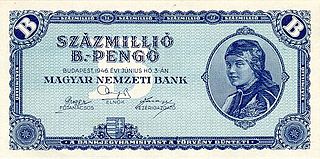
In economics, hyperinflation is a very high and typically accelerating inflation. It quickly erodes the real value of the local currency, as the prices of all goods increase. This causes people to minimize their holdings in that currency as they usually switch to more stable foreign currencies. Effective capital controls and currency substitution ("dollarization") are the orthodox solutions to ending short-term hyperinflation; however there are significant social and economic costs to these policies. Ineffective implementations of these solutions often exacerbate the situation. Many governments choose to attempt to solve structural issues without resorting to those solutions, with the goal of bringing inflation down slowly while minimizing social costs of further economic shocks.

The Weimar Republic, officially known as the German Reich, was a historical period of Germany from 9 November 1918 to 23 March 1933, during which it was a constitutional federal republic for the first time in history; hence it is also referred to, and unofficially proclaimed itself, as the German Republic. The period's informal name is derived from the city of Weimar, which hosted the constituent assembly that established its government. In English, the republic was usually simply called "Germany", with "Weimar Republic" not commonly used until the 1930s. The Weimar Republic had a semi-presidential system.

George Grosz was a German artist known especially for his caricatural drawings and paintings of Berlin life in the 1920s. He was a prominent member of the Berlin Dada and New Objectivity groups during the Weimar Republic. He emigrated to the United States in 1933, and became a naturalized citizen in 1938. Abandoning the style and subject matter of his earlier work, he exhibited regularly and taught for many years at the Art Students League of New York. In 1959 he returned to Berlin, where he died shortly afterwards.

Gustav Ernst Stresemann was a German statesman who served as chancellor of Germany from August to November 1923 and as foreign minister from 1923 to 1929. His most notable achievement was the reconciliation between Germany and France, for which he and French Prime Minister Aristide Briand received the Nobel Peace Prize in 1926. During a period of political instability and fragile, short-lived governments, Stresemann was the most influential politician in most of the Weimar Republic's existence.

Ethan of Athos is a 1986 science fiction novel by American author Lois McMaster Bujold. The title character is Dr. Ethan Urquhart, Chief of Biology at the Sevarin District Reproduction Centre on the planet Athos, who is sent to find out what happened to a shipment of vital ovarian tissue cultures. Set in the fictional universe of Bujold's Vorkosigan Saga, the novel mentions but does not feature her usual protagonist Miles Vorkosigan. To date, Bujold has never revisited the settings of Athos or Kline Station in her many subsequent novels, but the events of Ethan of Athos are later referred to indirectly in the novels Borders of Infinity (1989) and Cetaganda (1995).

Berlin Alexanderplatz is a 1929 novel by Alfred Döblin. It is considered one of the most important and innovative works of the Weimar Republic. In a 2002 poll of 100 noted writers, the book was named among the top 100 books of all time.

Groschen is the name for various coins, especially a silver coin used in parts of Europe including France, some of the Italian states, England, and various states of the Holy Roman Empire.

My Uncle Oswald is a 1979 novel in the sex comedy genre written by Roald Dahl.

End Zone is Don DeLillo's second novel, published in 1972.
Christopher Lehmann-Haupt was an American journalist, editor of the New York Times Book Review, critic, and novelist, based in New York City. He served as senior Daily Book Reviewer from 1969 to 1995.
The Golden Twenties was a particular vibrant period in the history of Berlin. After the Greater Berlin Act, the city became the third largest municipality in the world and experienced its heyday as a major world city. It was known for its leadership roles in science, the humanities, art, music, film, architecture, higher education, government, diplomacy and industries.

The Golden Twenties, also known as the Happy Twenties, was a five-year time period within the decade of the 1920s in Germany. The era began in 1924, after the end of the hyperinflation following World War I, and ended with the Wall Street Crash of 1929.

Friedrich Carl Georg Kaiser, called Georg Kaiser, was a German dramatist.
Ethan Mordden is an American author and musical theater researcher.

The Athenaeum of Philadelphia, located at 219 S. 6th Street between St. James Place and Locust Street in the Society Hill section of Philadelphia, Pennsylvania, is a special collections library and museum founded in 1814. The Athenaeum's purpose, according to its organizational principles, is to collect materials "connected with the history and antiquities of America, and the useful arts, and generally to disseminate useful knowledge" for public benefit.

Rudolf Emil Albert Havenstein was a German lawyer and president of the Reichsbank during the hyperinflation of 1921–1923.

Hyperinflation affected the German Papiermark, the currency of the Weimar Republic, between 1921 and 1923, primarily in 1923. The German currency had seen significant inflation during the First World War due to the way in which the German government funded its war effort through borrowing, with debts of 156 billion marks by 1918. This national debt was substantially increased by 50 billion marks of reparations payable in cash and in-kind under the May 1921 London Schedule of Payments agreed after the Versailles treaty.
Arthur R.G. Solmssen was an American lawyer and novelist.
Joseph Koeth was a German military officer and politician. During World War I he served as head of the Kriegsrohstoffabteilung of the Prussian Ministry of War created by Walther Rathenau. After the German revolution of 1918, Koeth was in charge of economic demobilisation as a member of the first democratically elected government under Philipp Scheidemann. He again served briefly as a minister of the Weimar Republic under Gustav Stresemann in 1923.
Hellmut Otto Emil Lehmann-Haupt was a German-American author, academic, bibliography expert, and rare books expert. After World War II, he worked with the Monuments, Fine Arts, and Archives program, commonly known as the Monuments Men.














